Monday, May 22, 2006
First Real Day of the Season 2006
Suits are not my thing. Really. Everyone who knows me knows that. So it was really unusual for me to wear it. But it was worth it.
This also meant there'd be 24 hour launch service for the season! And that, my friends, is terrific. No more buzz-kills swimming or kyacking back to the boat after an evening of heavy drink! No sirree, just saunter along the dock (nice and wide, new decking for the vertically challenged), wake up the launch driver, and try to tell them where your boat is without looking too foolish.
What a pleasure!
So after the party, I took the launch (did I mention, I could have taken it at 3:00am? Pick a time - I could take it!) to Inertia, and settled down for a wonderful sleep. The wind and water were just right, the temperature exquisite, all snuggly in my sleeping bag.
When I arose around 9:30, I noodled around, made some coffee, added a splash of solar powered refrigerated half and half, and listened to NPR. Around lunchtime, I closed up the boat, summoned the launch, and toddled off to the club for a bite of lunch.
After a terrific hamburger, I decided to go home to start work on Laura's dodger - I'm replacing the eisenglas on the sides and adding a new through-window port for her preventer. I've got most of the idea down, but am working on a way to prevent the preventer from wearing through the protector again and allow a flap to seal the hole when the preventer isn't rigged.
We'll see how successful I am. What I need is a bigger sewing machine, but I'll tax this one (a Kenmore) for a little longer.
Pictures when done!
The Memorial Day Weekend is shaping up nicely. Friends at different ports - should be fun! I'll probably go to the boat Friday and maybe sail to Connecticut to meet them.
Pictures when done, and more adventures!
See you on the water!
Monday, May 15, 2006
A Wonderful Sail
This June I'll be taking my first offshore passage of any length from Bermuda back to Staten Island, NY (just past the Verrazzano Bridge) in New York Harbor. It is about a five day trip. This will decide, in some way, my future. Do I cruise to the Caribbean? To England? To the Mediterranean? Or do I sell it all and get a small but functional RV and travel Canada, the United States, and Mexico? Hmmm?
One of our crew members for the trip back is Julie whom I invited for a sail. She's very much into weather predicting and routing and celestial navigation. Still, when you go offshore with an unknown crew, you'd like to know that they're someone you can depend on. And of course, I'd like her to know the same, so going for a sail was a pretty good way to introduce ourselves.
The day was cloudy, but comfortable in the mid sixties with the wind predictably nowhere near NOAA said it would be - out of the east-southeast at about 10 to 12. In other words, perfect to see how the boat really handles with the new sails. It's the first time I've been able to sail for an extended period on one tack or another and fiddle fart around with the trim.
So we sailed off the mooring, around the southern tip of City Island, up between Hart Island (Potters Field) and City Island, through the channel between David's Island and
Hart Island, down to Manhassett Bay, back north of Execution Rock Light, southeast to Hempstead Bay, and then wing-on-wing back to City Island Yacht Club.
The sails handled magnificently, although I'd like the clew of the jib to be a little higher so I don't have to skirt it after each tack. Also, with the clew so low, in light winds I can't flatten the sail without the top hitting the shrouds. In higher winds when the jib car goes back and twists the top off, no worries. All in all though, wonderful. Listen: I'm still thrilled with the sails, and you will be too if you call Somerset Sails.
We picked up the mooring under sail in only two tries, and miraculously, no one got hurt! Another successful sail!
After putting the boat away, we popped into the club for a bit of a tipple. Mmmm. Well and good. Then the drive home.
I've met a friend for life, and would not only sail anywhere with her, but invite her aboard Inertia without reservation. She knows her stuff (actually, she knows a lot more than I do, but I found that out later, much to my embarrassment... Oh well. Color me red.)
Plans are afoot for Memorial Day weekend, and next week, the Commissioning Party at the Club. I am just still tickled pink to say that. Maybe next year I'll get used to it. Hey, maybe not.
I'll get some pictures together, and now that the work stuff is done, they'll be playtime pictures. The only project I'd like to show you is the repair to the seating in Cassiopeia. It's interesting in an engineering sort of way. Let's see if it works.
Until then, though, I'll see you on the water.
Saturday, May 13, 2006
Just WTF Are We Thinking?
That aside, yesterday I helped my longest and best friend, Leigh, do some trim work on a house of a friend of his. Apparently, the contractor had gone bankrupt or whatever, and wasn't working on the house. There are other financial considerations but they're not the important thing right now.
What is important is that the quality of work done in a very expensive addition and remodeling project is awful. I've avoided carpentry for most of my life - woodworking escapes me for some reason. Glass, metal, plastic, electronics, electrical, plumbing, and so forth - no problem. With carpentry, I could not get the quality I wanted out of the work I do. I have no idea why. I know how to measure (you'd be surprised at how many people don't). I can use power tools. I can even use really, really big power tools (like excavators).
But I can't seem to get wood to work properly.
Apparently, I've been worrying needlessly. It's clear that the contractor at this job hired less than skilled workers for the job. Sadly, nearly every doorframe we put the trim on was wracked or twisted. What should have been a four or so hour job took all day since every single cut except for four were custom.
It is sad to see someone spend so much time and money for an addition and get so thorougly screwed - and the subcontractors, too.
There is a point to all this saddness - and it really does make me sad - namely, where are we going as a people, as a nation? We complain about the quality of work, yet we work so terribly or accept awful work. We complain about nonskilled workers taking our jobs, but we won't do them.
We want more money, more benefits, more of everything but we don't want to work for it. We have an overrated estimate of our own worth. Just a hint: We're worth no more and no less than anyone else.
It makes me really angry that a contractor can behave so badly. And he'll get away with it, too, I'm sure. And that's really sad.
That's the end of my rant for today.
Tomorrow - down to the boat for a little sailing, weather permitting. Well even if not. Still gotta go!
Hope to see you on the water!
Sunday, April 30, 2006
Getting Cassiopeia Ready
 One of the great thing about hanging around marinas and having friends that do things like the Newport to Bermuda race is that you get to see some very cool stuff going on. Often, you get to help, especially if it involves moving a lot of heavy stuff around. How could you not participate in that?
One of the great thing about hanging around marinas and having friends that do things like the Newport to Bermuda race is that you get to see some very cool stuff going on. Often, you get to help, especially if it involves moving a lot of heavy stuff around. How could you not participate in that?We moved Cassiopeia, a Beneteau 42.7 from Norwalk, Connecticut on Saturday - it was just a two hour ride, easy as pie. Since no sails were aboard, no sailing occured, but we still managed to down a box of Triscuits, a pound of Brie cheese, and a hot soprasata. Can't go sailing without food, you know.
Anyway, after arriving at Stanford, Ct. for the summer berth, I took off to my boat, now at the City Island Yacht Club (CIYC from now on). How I got Inertia there is a story of motoring through the rain and fog from Haverstraw the weekend before. That week, it was Triscuits, cheddar cheese, and pepperoni. But that's another story.
I spent the afternoon taking down my small headsail and rehoisting my big genoa. Then I had to go sailing, and because the wind was light, I practiced docking under sail and picking up my mooring under sail. If you own a sailboat, you should do this, too. It's fun and educational. Once again, I digress.

So, after putting the boat away, I had dinner at the club. Let me repeat: I had dinner at the club. I love saying that. My friends will soon get sick of me saying it. I suppose I will, too, when the novelty wears off. But for now, I must reiterate, I had dinner at the club.
Ok, Sunday, (today), we had to go back to Cassiopeia to help the measurer measure her for the Newport - Bermuda race. Laura had two measurements made: ORR and IRC. You can look what they mean somewhere else. But the ORR measurement involves, in addition to some underbody measurements while the boat is out of the water, calculating the righting moment of the boat. For the Newport - Bermuda race, the righting moment must be 115 degrees or better.
 The righting moment is a measurement of the ability of a boat to right itself if knocked down. Clearly, a boat with a low righting moment, like 90 degrees means that if the boat assumes an attitude of mast parallel to the water or lower, it will continue and turn over. That's not good. Boats like Sunfish's and so forth have a low righting moment - very easy to turn over. 115 degrees means that the mast can be up to 115 degrees from verticle and the boat will still right itself.
The righting moment is a measurement of the ability of a boat to right itself if knocked down. Clearly, a boat with a low righting moment, like 90 degrees means that if the boat assumes an attitude of mast parallel to the water or lower, it will continue and turn over. That's not good. Boats like Sunfish's and so forth have a low righting moment - very easy to turn over. 115 degrees means that the mast can be up to 115 degrees from verticle and the boat will still right itself.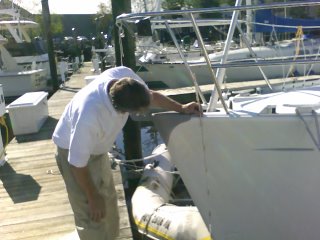 If you could get a boat to behave like a Weeble (Weebles wobble but they don't fall down), the you could have a really safe boat.
If you could get a boat to behave like a Weeble (Weebles wobble but they don't fall down), the you could have a really safe boat.The way to measure this is to hang long poles out from the boat with lots of weight on them - and then move the weights and measure what happens to the
 boat. Well, it's a little more complex than that, but essentially, you want to tip the boat and see how hard it was to do.
boat. Well, it's a little more complex than that, but essentially, you want to tip the boat and see how hard it was to do.Also, because there are other measurement systems, like IRC, other rules apply; namely, you have to remove everthing from the boat except what it came with. Do you have any idea how much crap an empty boat has in it? Laura emptied hers before winter. This is what's left. Or half of it anyway. It continues along the finger, too.

 Once the deck measuring was done, we sent Laura up the mast for all the measurements for sail hoist, mast height, and headstay length.
Once the deck measuring was done, we sent Laura up the mast for all the measurements for sail hoist, mast height, and headstay length. In case you're wondering what this whole thing costs besides a few hours with all your friends moving all your crap around is about $600. If you're serious about racing, especially offshore, this is what you'll need to do.
On another entirely different note, there is a company in Northport, Long Island that is owned and run by a really cool guy- a boater's engineer. The company is Sailor's Solutions, and I've put the link on the sidebar. If nothing else, call and get a catalog. There's really stuff you need and didn't know you needed it or that it even existed.
Their flagship product used to be their very own designed and manufactured sound proofing for engine rooms called SPM. If your engine is noisy and your sound insulation is falling apart, replace it with this stuff. It's great. I used it and even though I couldn't get to the aft wall of the engine room to remove or replace the old stuff, installing SPM still reduced the engine noise so much that I could actually listen to the radio down below when motoring. Highly recommended. It's strong (not like that mylar/foam stuff), it's solid foam with stiff surface, and it sticks like the dickens.
After I replaced all my interior lights with the LED's I started looking for navigation lights. It turns out Sailor's Solutions has designed and manufactured with the help of NASA some very cool lighting solutions. They were kind enough to send me a SensiBulb (their name) to try out. It has a slew of advantages, including being a yellowish light instead of the blue white, and it has temperature sensing so that it doesn't allow the LEDs to get too hot. Apparently they fail at 140 degrees - I didn't know that.
Soon they'll be carrying the new OPM navigation lighting. I want it. They'll have the best price, too, since I've also asked about that, too.
So more on that later - but really, give them a shout. I got a copy of their catalog and darn it all, there's stuff I want - even a really excellent winch handle holder. You don't know you need it. But you do. Trust me.
Anyway, it's sailing season - so now I really will see you on the water!
Monday, April 17, 2006
WOW! Simply WOW!
That said, here goes. First, April 8th was the big opening of the City Island Yacht Club's kitchen for the year. So the club put on a wine tasting (mmmm...Wine...) and of course you could have dinner. My friend Laura came along, and we had a terrific time! The food was good and very reasonably priced. I don't believe I'll have any problem meeting my $500/year minimum. None at all.
It was amazing - when I visited in February, the place was a total disaster - walls torn apart, holes, general confusion. Yet Saturday last, it was beautiful! Newly painted, and absolutely fantastic! I can't say enough. I suspect I'll be helping out this year. It's a club to be proud of, and I believe I made absolutely the right choice!
From the sublime to the mundane. Two projects needed finishing, the LED lighting with a red nav station light, and permanent mounting of the solar panels.
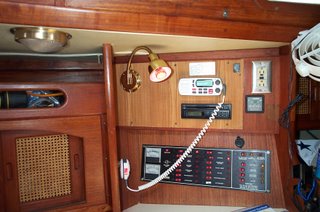 The nav station light was the hardest, believe it or not. First, I had purchased a red 19 LED single contact bayonet bulb for the purpose. Needless to say, I should have researched lighting first. The only manufacturer of bayonet socketed flexible gooseneck lights is Sea Dog, and theirs is a double contact socket. Ok, so I called them and no, they can't make one with a single contact. Feh!
The nav station light was the hardest, believe it or not. First, I had purchased a red 19 LED single contact bayonet bulb for the purpose. Needless to say, I should have researched lighting first. The only manufacturer of bayonet socketed flexible gooseneck lights is Sea Dog, and theirs is a double contact socket. Ok, so I called them and no, they can't make one with a single contact. Feh!Most of these new lights are xenon bulbs or high intensity bulbs with red filters. The sockets are nothing like anything useful for my purposes. So I purchased the light I wanted and ripped it apart. I epoxied an automotive single contact bayonet socket in it, and wired it all up. Great. The only thing I don't like is that the bulb is proud of the reflector, but you know what? if it becomes a problem, I'll think of something else.
 Next, I've been struggling on how to mount the solar panels permanently. It has to be strong enough to support my weight without flexing, and preferably maintenance free. My choice for maintenance free material is HDPE (High Density PolyEthylene). It's essentially Starboard, but cheaper because it's generic. It's easily machinable with either woodworking tools or machine tools, and it is totally inert. I mean really, really inert. So inert that the only method of joining is mechanical.
Next, I've been struggling on how to mount the solar panels permanently. It has to be strong enough to support my weight without flexing, and preferably maintenance free. My choice for maintenance free material is HDPE (High Density PolyEthylene). It's essentially Starboard, but cheaper because it's generic. It's easily machinable with either woodworking tools or machine tools, and it is totally inert. I mean really, really inert. So inert that the only method of joining is mechanical.So, with my friend Leigh's help, I built a platform with wedges under to make up the curve on the sea hood over the companionway hatch. Because the HDPE is not dimensionally stable (it does expand and shrink some) I attached it centerline to the hood. that way it can expand and contract.
The panels slide under an aluminum angle mounted on the forward edge, and are screwed into the mounting at the other end. Originally I wanted to be able to move the panels when at a dock, but I don't really see the need. They're fine where they are.
Wedges underneath in milled slots make up for the curve in the seahood. I can stand on them if necessary although I hardly ever walk right there. Laura was impressed. She said it looked as if they belonged there.
We went sailing Easter day when it was sunny. The panels provide enough power in bright sunlight to power the stereo, autopilot in standby mode, depth and speed instruments and still charge the batteries. I haven't yet tried them on the chartplotter or autopilot in active mode, but I hardly ever ust the chartplotter, and autopilot only long enough for food and head breaks. More on this later, of course. So far, though, I've been able to get a little over 2 amps out of the panels.
Finally, yesterday the wind was 20 to 25 knots out of the northwest. I wanted to try the new yankee, so I wrestled down the big jib, and set it. Wow! Holy Smokes! I can see this becoming my favorite sail! With just that sail we tooled along at 4 to 6 knots! The boat was totally controlable, and the sail and rig hardly stressed at all. It's perfect! I am thorougly impressed! If you need sails - call Martin at Somerset Sails. Mention my name. I don't know that will help, but it can't hurt.
This summer I'm going to get my friend Lou to take pictures of Inertia under sail. That's how tickled I am with her.
I hope to see you on the water - soon, too!
Sunday, April 02, 2006
Spring is Definitely Here Now
This required bringing in wires from the seahood (the thing that covers the open companionway hatch) where the panels will be mounted, to the battery bank 1 (the house bank).
Speaking of which, I was watching the Xantrex charge monitor and realized it wasn't indicating battery charging - power always went down, never recovered, which is one of the monitor's big pluses. So a quick call to Jack Rabbit Marine, and some patient explaining by Steve, moving two wires, and badaboom badabing, fuggedabouddit. Here's the thing, all the ground wires must be on the load side of the shunt. That's important - even the charging source grounds. So I moved the shorepower battery charger's ground and the starting battery's ground, and that's that. Also, the solar panel's ground was attached there, but more on that later.
Right, then, back to the solar panels. This is a simple wiring job, and because there is no simple way to electrically from the deck to the batteries with an intermediate cabin stop, I ended up with some exposed wire, but I'll cover that later.
The only interesting thing about the whole installation is that I used wire from Ancor that's round with two #12 conductor wire, one red, one yellow. "Huh?", you might say. "Yellow? Why yellow?"
Traditionally the ground wire in 12 volt systems is black. That's fine on a car where it's all 12 volts. What about in mixed 120 VAC/12 VDC systems like a boat? Black wires are hot for 120 VAC (the others, white is neutral and green is ground). So to avoid confusion, let alone some spectacular sparking, fire, and possible electrocution, ABYC, NMMA, and other boat building associations have decided to make 12 VDC ground yellow.
You might wonder, then, why I used red and black on the rebuilt lights. That's a reasonable question. Nothing, I mean, nothing can be more confusing than changing the color of a wire mid circuit. Even though the lighting connections are very obvious, it's better not to 'improve' on what's already there. For new circuits, use the new standard. Red, hot, yellow, ground.
 Back to the solar panels. I decided to put a panel connection on either side of the cabin rather than one connection requiring the panels to be tied together. This is so I can reposition them independently for dockside. Jack Rabbit Marine supplied me with the watertight connectors and the wire clams for going through the deck. I decided on this arrangement because I won't crack anything by stepping on it. Also, it's pretty much out of the way. There's one on the starboard side, too.
Back to the solar panels. I decided to put a panel connection on either side of the cabin rather than one connection requiring the panels to be tied together. This is so I can reposition them independently for dockside. Jack Rabbit Marine supplied me with the watertight connectors and the wire clams for going through the deck. I decided on this arrangement because I won't crack anything by stepping on it. Also, it's pretty much out of the way. There's one on the starboard side, too. Next, I installed a terminal block in the headliner to join the panel leads. This also allows future expansion, should I need it. Here you can see the red and yellow wires. The panels are connected nearest to you and the battery feed is, obviously, on the other side. The terminal block is mounted on a very thick fiberglass pad that the old traveller is bolted to.
Next, I installed a terminal block in the headliner to join the panel leads. This also allows future expansion, should I need it. Here you can see the red and yellow wires. The panels are connected nearest to you and the battery feed is, obviously, on the other side. The terminal block is mounted on a very thick fiberglass pad that the old traveller is bolted to.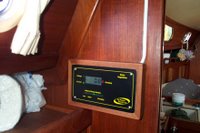 Next, the solar charge monitor panel was installed in a place where I could run most of the wire out of sight in the hanging locker, through a bulkhead into the battery box. The ground, of course, is attached to the shunt and the hot to the main battery bank. The wire I'll cover as soon as I figure out how, but here's what I have to say about that - there is no, I mean no place on a boat for silicone sealant. It virtually guarantees a leak and one that's impossible to fix. However, a little dab behind the wire and it holds it to the wood like that's what it's meant for.
Next, the solar charge monitor panel was installed in a place where I could run most of the wire out of sight in the hanging locker, through a bulkhead into the battery box. The ground, of course, is attached to the shunt and the hot to the main battery bank. The wire I'll cover as soon as I figure out how, but here's what I have to say about that - there is no, I mean no place on a boat for silicone sealant. It virtually guarantees a leak and one that's impossible to fix. However, a little dab behind the wire and it holds it to the wood like that's what it's meant for. Finally, here's where the cells are going. I'll add another picture when I finish the mount, but this essentially is it. The devices will keep the batteries totally charged, and in bright sun, run the refrigerator as planned.
Finally, here's where the cells are going. I'll add another picture when I finish the mount, but this essentially is it. The devices will keep the batteries totally charged, and in bright sun, run the refrigerator as planned. I'll see you on the water, but with fully charged batteries!
Friday, March 24, 2006
Changing the Lighting
Also, until now the cost of white LED (Light Emitting Diode) lights have been prohibitive - but one of our sailing buddies has found the Super Bright LED site where you can purchase LED bulbs for interior lighting up to and including navigation lights. Laura is replacing her low down lamps which draw 25 watts each (or a little over 2 amps each) with LEDs that draw .2 amps each! That's some savings - especially when overnight racing.
Another incentive to change the lighting is that one of my overhead lights' bulb burned out and in the process of replacing it, the whole thing fell apart. Since I had to replace the fitting anyway, I thought I'd try the LED thing, which is less expensive by an order of magnitude than replacement of the fitting.

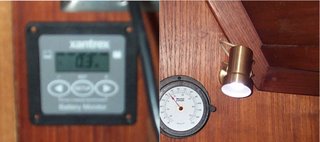
Above is an example of the kinds of power saving possible - at least with a spot/reading lamp. The first picture is of the Xantrex reading with the incandescent bulb, and the other with the LED. To get the thing to work, I had to rewire the lamp because the LEDs are polarity-sensitive. This is important, because I thought the bulbs were bad, but when all three didn't work, I knew that wasn't the case. But these bulbs (bayonette, one contact) are $9.99 each and they last for 10,000 hours.
You can see the difference is marked - 1.5 amps to .3, and this is the biggest brightest bulb I could get (19 LEDs as opposed to 12).
So, I removed all the other lighting fittings and brought them home so I could work in comfort. First, I disassembled the lamps. They're typical Guest lamps. They're cheaply built, and have only been saved from certain corrosion into oblivion by the fact that Herb and I keep a really dry boat. The only thing I kept from the fitting was the switch. This picture shows the fittings beforehand. Notice I'm replacing those silly bulbs with a 36 diode array. Also notice the array has a socket on it, which I'm going to remove. The bulb in the fitting is held by two cheap clamps, and they fall apart when you remove the bulb. The first step is to remove everything and clean up the fitting. I used a drill to remove the remaining bulb holders, and de-soldered the switches. It turns out the wiring was all cheap - like speaker wire, and showed corrosion inside insulation. So, here's what I have to say about that: I hope Guest has upgraded their manufacturing. If they're making stuff for the marine industry, they should be doing it right with tinned wire.
The first step is to remove everything and clean up the fitting. I used a drill to remove the remaining bulb holders, and de-soldered the switches. It turns out the wiring was all cheap - like speaker wire, and showed corrosion inside insulation. So, here's what I have to say about that: I hope Guest has upgraded their manufacturing. If they're making stuff for the marine industry, they should be doing it right with tinned wire.Although you can't see it, the sockets are off the LED panels.

I drilled holes in the center of the fitting to run the LED's leads through. Next, I used a really terrific product, called 'AquaMend', an epoxy stick, that I got from West Marine, to attach the LED panels to the reflector side of the fitting. This stuff hardens in 5 minutes above the water or below! Everyone should have some. I made 1/2" balls and pressed the circuit board into them leaving the board slightly above the surface of the fitting to ensure there won't be any shorting.
 Finally, on the other side, I soldered the red lead to the switch, extended the black lead, and soldered a new red lead to the switch. Then I tested the light with a 12V power supply. The last thing was to put a dab of 3M 5200 where the leads come through the reflector so that if the lamp hangs on the leads, the stress isn't on the solder joint on the circuit board.
Finally, on the other side, I soldered the red lead to the switch, extended the black lead, and soldered a new red lead to the switch. Then I tested the light with a 12V power supply. The last thing was to put a dab of 3M 5200 where the leads come through the reflector so that if the lamp hangs on the leads, the stress isn't on the solder joint on the circuit board.I also crimped on spade fittings so that the next person to remove these lamps doesn't have to cut the wires.
 I've reinstalled all these lamps and here's a picture. I think they will provide more light, and a much pleasanter white-blue color. I happen to like it, but not everyone will.
I've reinstalled all these lamps and here's a picture. I think they will provide more light, and a much pleasanter white-blue color. I happen to like it, but not everyone will.
The last light, the spot, is pictured here all rewired.
Saturday, March 18, 2006
There's Lots to Report
 Last weekend, though, Herb and I installed a new battery by cutting a hole in the area next to the current batteries (I explored that by cutting a small hole), installing a mount and hatch, setting the battery in, and wiring it up. Easy, huh? I thought it would be a couple of hours - it was all day, like 6 hours!
Last weekend, though, Herb and I installed a new battery by cutting a hole in the area next to the current batteries (I explored that by cutting a small hole), installing a mount and hatch, setting the battery in, and wiring it up. Easy, huh? I thought it would be a couple of hours - it was all day, like 6 hours!To review, I made the currently installed batteries a single bank (1), and the wire from bank 2, now is removed from the battery box (you can't see it, though).
 First, I got a latching hatch cover from Defender, traced the opening, and cut it out. After making sure it fit, I epoxied the edges because oddly enough, that deck is balsa core. Who'd think it? Anyway, this particular hatch is strong, latches and is waterproof. Not that I need it there, but if you're thinking of putting one in your deck (for through cockpit sole engine access) this is a good one - the opening is 10 x 12", big enough for batteries...
First, I got a latching hatch cover from Defender, traced the opening, and cut it out. After making sure it fit, I epoxied the edges because oddly enough, that deck is balsa core. Who'd think it? Anyway, this particular hatch is strong, latches and is waterproof. Not that I need it there, but if you're thinking of putting one in your deck (for through cockpit sole engine access) this is a good one - the opening is 10 x 12", big enough for batteries...Finally, using adhesives, marine putty and epoxy, mahogany bars, and some ingenuity with a sabre saw, I made a frame that will hold the battery level. I 3M 5200'd the battery holder to the frame, installed the battery, and wired it up. Cool.
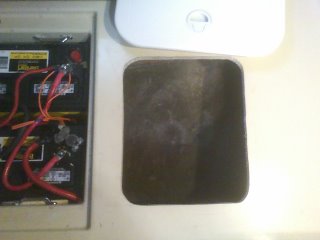



This week, Laura and I are
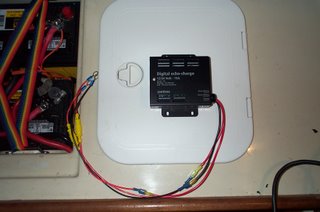 installed the Echo Charger from Xantrex. What it does is charge the starter battery when any charger source is on and the voltage is low on the starter battery. It's all automatic. And it isolates the charging systems from any of the load busses, which was one of the points of this exercise. The other, of course, is to make sure that even if I run the house batteries down, I still have power for starting the motor.
installed the Echo Charger from Xantrex. What it does is charge the starter battery when any charger source is on and the voltage is low on the starter battery. It's all automatic. And it isolates the charging systems from any of the load busses, which was one of the points of this exercise. The other, of course, is to make sure that even if I run the house batteries down, I still have power for starting the motor.Mount the box somewhere (you can see I mounted it near the
 starter battery on the forward bulkhead of the new storage area. The rest turns out to be a simple three wire set up. Run the red to the main bank, run the white striped red to the starter battery, and the black to ground. Badaboom, badabing! Fuggeddaboudit!
starter battery on the forward bulkhead of the new storage area. The rest turns out to be a simple three wire set up. Run the red to the main bank, run the white striped red to the starter battery, and the black to ground. Badaboom, badabing! Fuggeddaboudit! Last Monday, my friend Leigh and I went for a hike in Tallman State Park, from Stateline Lookout in New Jersey to a very pretty little waterfall near Lamont Dougherty Geological Laboratory. It's a great little walk along the Palisades with excellent views of the lower Hudson River.
Last Monday, my friend Leigh and I went for a hike in Tallman State Park, from Stateline Lookout in New Jersey to a very pretty little waterfall near Lamont Dougherty Geological Laboratory. It's a great little walk along the Palisades with excellent views of the lower Hudson River.It was such lovely weather I had to take my shirt off! Beautiful!
I know you're getting tired of seeing Inertia at a dock, but Friday night I made patterns for
 the letters to the name and cut them out of self-stick UV treated white dacron. I'm happy to tell you all the technical crap, but I believe even you all have a limit... Anyway Martin of Somerset Sails offered a free riding sail, and so, there it ia along with the new sail cover.
the letters to the name and cut them out of self-stick UV treated white dacron. I'm happy to tell you all the technical crap, but I believe even you all have a limit... Anyway Martin of Somerset Sails offered a free riding sail, and so, there it ia along with the new sail cover.If you don't know what it's for, it's for being at anchor or mooring. You set it to help stop the boat from 'sailing at anchor'. Most boats without full keels do that. You could also use it in the case that you're deploying a sea anchor to prevent the same sailing about it, too.
Monday is the first day of spring, so I'll be seeing you on the water real soon now!
Sunday, March 05, 2006
A New Battery Monitor and News From Across the Pond
Rewiring the batteries was a snap - a couple of minutes. But getting the sensor/power cable from the power panel above the nav station to the batteries was a horror show - Herb took the whole lazarette apart to find a path for the thing, and finding that wasn't necessary, put the whole thing back together again!
Laura is doing essentially the same upgrades to her boat so was interested to see what this was all about, and got some pointers on how to do the wire crimping and so forth. And she has an incredible curiousity about all things mechanical/electrical on a boat. She's an awesome surgeon, yet thinks mechanical stuff is a mystery. Anyway, I'm glad to be able to impart some small wisdom to her.
Here are some quick pictures of the project.

Here's the nav station with the main board out, getting ready to cut a hole for the monitor. I decided to put the monitor below the 120v plug so I leave what little real estate I have in the removable panel for something special, like a radar display.
I really hate cutting holes in the boat - it seems so final. You really can't put the plug back in. Using the supplied template, I marked the center and the 4 screw holes. A 2" hole saw, and ba-da-boom, ba-da-bing, fuggeddaboudit!
Laura and Herb wired up the head (meter, whatever) according to the instructions. I was working in the battery well, so here's a picture of it wired. It turns out the terminal screws are little tiny screws - Laura volunteered to run to Grand Union and pick up an eye-glasses screwdriver for the task. Jack Rabbit provided 25 feet of 8 conductor cable for the installation - you only need 5 conductors unless you install the optional battery temperature monitor.
Here is the whole panel back in with the Xantex monitor on and functioning. Woohoo. The thing is incredible - it measures battery load down to .1 amp, and keeps track of amp hours used, number left (you have to tell it how many you have to begin with). And a whole bunch of other stuff. It's the beginning of an integrated power management system.
 The batteries are two group 29's (an odd size, I'm told, but they really are. It says so right on the battery). Ok, so the battery farthest away is battery #2, and nearest, #1. If you take the time to follow the wires, you'll see there's two big red wires and one black that connects both grounds. Hence, two banks of one battery each.
The batteries are two group 29's (an odd size, I'm told, but they really are. It says so right on the battery). Ok, so the battery farthest away is battery #2, and nearest, #1. If you take the time to follow the wires, you'll see there's two big red wires and one black that connects both grounds. Hence, two banks of one battery each. Now, the batteries are paralleled and connected to the battery switch's #1 position for a big house bank. The other red lead is actually laying in the opening at the left. I was thinking of putting the started battery in that hole, but it crowds the stuffing box. So not there - as it turns out, there's a huge area to the right of the battery box that can be, what else? A new battery box. I'll install a 12" x 15" hatch. I don't understand why this wasn't made a storage locker when the boat was built.
Now, the batteries are paralleled and connected to the battery switch's #1 position for a big house bank. The other red lead is actually laying in the opening at the left. I was thinking of putting the started battery in that hole, but it crowds the stuffing box. So not there - as it turns out, there's a huge area to the right of the battery box that can be, what else? A new battery box. I'll install a 12" x 15" hatch. I don't understand why this wasn't made a storage locker when the boat was built. Finally, the device you see before you is the heart of the battery monitor - basically it's nothing more than a really big low resistance resistor. The monitor monitors the current across it. (Actually the voltage drop, but close enough. It can calculate the current from that.) That big yellow wire is the ground - new marine wiring standards suggest the ground in boats should be yellow on 12 volt systems so the black doesn't get confused with black hot in AC systems. A great idea.
Finally, the device you see before you is the heart of the battery monitor - basically it's nothing more than a really big low resistance resistor. The monitor monitors the current across it. (Actually the voltage drop, but close enough. It can calculate the current from that.) That big yellow wire is the ground - new marine wiring standards suggest the ground in boats should be yellow on 12 volt systems so the black doesn't get confused with black hot in AC systems. A great idea.After a hard day's work on this completely successful installation, Gina had a wonderful turkey dinner ready for us! A couple of glasses of wine, great food, and summer plans. Also - Laura and I are replacing our interior lamps with white LEDs. There's a company Super Bright LEDs that has really good prices for the bulbs - and they have 1/10 the power requirements of incandescent bulbs. So I'll let you know about them.
Now for something completely different. Renee has tackled a huge project that seems to include ripping out her heating system and well, apparently the whole interior as well. I'm dying to see what it looks like, so I surely do hope she sends some pictures along. Big job, and she's indicated that sometimes you can have too much help!
Well, next week I'll be installing solar panels, I hope.
See you on the water!
Saturday, February 25, 2006
Philosophy and So Forth
I've been fond of saying, "Original thought is far more rare than you might think. Most any thought you or I have had in our life has been or will be thought by someone else." I don't ask you to dwell on that. Perhaps it's better if you don't.
Anyway, it turns out I'm an existentialist. To be exact an atheist existentialist. Jean-Paul Sartre is the main man for that one. The long of the short of it is that it is the closest philosophy to humanism there is, maybe even the same, close enough.
So now we all know what I am. Can I justify this position? Sure. Will I? No problem. Just not here. Or now. Maybe later. I mean, really, I have to keep something in reserve.
Ok, you're wondering what's going on in the sailing world. I called Sound Salvage in City Island to order a new mooring system for Inertia at the yacht club. They have standards, and although my boat would probably be ok with a 400 lb. mushroom, I ordered a 500 lb. one.
Sound Salvage has been doing this for a long time, and they take care of most of the moorings on the west side of City Island. They also, for an annual fee, inspect and maintain the pennants (the part that goes from the mooring chain to the boat), and once every other year they haul the mooring and inspect and repair it (an additional fee). But to keep your boat afloat and attached, that's the kind of dedication you really want.
I'll be getting the scoop on my new mooring set up and get some pictures, too.
My friend Bobbie (and Warren) has given me a link to an interesting site, and if you're doing coastal sailing, especially in the northeast US, you might like this, too. It's interesting even if you're not sailing around here, but there is a lot of area specific info. So here it is: http://www.coastalsailing.net/
I have been promised by Renee (of narrowboat fame) that there are pictures and notes about her redoing the inside of Coriander (Corry). Apparently she (Corry) is in a bit of a state. Well, maybe Renee, too, but I can't speak to that. Anyway, now that I've promised it, she'll have to come through.
Laura, Herb and I spent today checking out their boats in Norwalk, Connecticut. We made plans for the summer cruising and racing - For instance, my friend Laura will be doing the Newport-Bermuda race, and I'll help her get the boat back. Also, we'll do the Around Long
Island Race (www.alir.org). Then dump her boat off to get it cleaned and repaired after the race, get to my boat and meet up with Herb and Gina, Bob and Carol.
Great plans. Easily lead astray. We'll see how that goes. I want to go through the Cape Cod Canal, see Cuttyhunk, and Tarpaulin Cove. Once again, we'll see.
The days are getting noticably longer now, and it's usually in the 40's during the day, 20's at night. Spring is right around the corner!
I've gathered all the info I need about my electrical upgrades to the boat. The new starting battery is going to be a deep cycle group 24 which is more than enough to do the job. It will be its own bank, and the current group 27's will be wired as a house bank. The solar panels will be attached to a charging bus with the current battery charger and the alternator. A new sensor panel will maintain all this crap. See my last post with it's picture.
This year is going to be a terrific season, I just know it!
I'll see you on the water!
Sunday, February 19, 2006
Big News! I Belong To A New Yacht Club
Well, to make a long story short, I joined City Island Yacht Club. There were members there working up a storm on the building, rebuilding the ladies lounge, moving a big doorway, and so forth. Now I have to deal with a mooring. Monday I'll be getting a quote for a 500 pound mushroom from Sound Salvage - I'll let you all know how that goes.
In the meanwhile, I've received my solar panels - I ordered them from Sundance Solar. They have charging systems for RV's and vacation homes and so forth, but they don't have a set with a charge controller and the two panels I wanted - they fit on the seahood and the others don't or are too small. I bought the two 22 watt panels that provide 1.2 amps each (maybe a little more).
Ok, the point here is not how much power ( I've already discussed how much power I need for the refrigerator) but that Sundance Solar was kind enough to give me a deal - The panels were $245 each and the other kit's controller was $119 - but they gave me the two panels and the controller for $550, and they threw in shipping besides. If you're going for solar panels, they have good prices and they are very nice to deal with.
Now that I've got them it's time to figure out all the other power issues, the first being separating the house batteries from the engine starting battery. So the first project is, you guessed it, add a starting battery. Towards that goal Herb and I went down to the boat today (Sunday) to see where the engine starting battery can go. It turns out I can put it under the aft cabin berth behind the shaftlog. I'll get some before before, during and after pictures.
Also, to do all this, I'll need some stuff from Jack Rabbit Marine . To show you what the generalized electrical diagram will look like, check the diagram below.
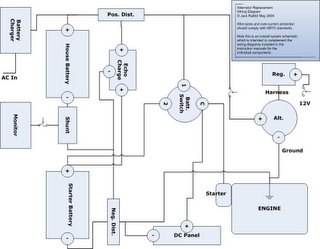
The key item here is the device labeled "Echo Charge" which monitors battery temps and charge to make sure the batteries don't get overcharged. So now you know the plan. I'll take pictures and so forth to keep you informed and hopefully interested.
See you on the water!
Saturday, February 11, 2006
Well, This is A Wine Fueled Blog Post
What does this mean? Well first of all, it means I made some truly spectacular chili. It also means that I am willing, under the influence of Bacchus, to share this particular recipe for the aforementioned chili.
For those of you who exist in a vacuum (and why does 'vacuum' have two 'u's?) or have not heard of the value of personal chili recipes, this is an extraordinary offer, indeed. It is on the order of the Patriot Act secrecy, it is on the order of the secrets of dark matter, black holes, and quantum mechanics. It is the holy grail, the gustatorial equivalent of the unification theory of everything!
Yet now I offer this to you; I offer a chili recipe that will excite the palate, will enrage the tongue, will cause the wailing of women, the gnashing of teeth, and full grown men to fall weeping to their knees; yea - the shaking of the very foundations of philosophy that binds our race together!
A bit much?
I think not.
Here we go:
First, you will need these things:
A can of black beans
A can of red kidney beans
A can of pinto beans
A can of Ro-tel - diced chilies and tomatoes - there are other manufacturers, too
A big can of tomato sauce
A big can of tomato puree
A pound or so of lean ground beef
A half pound or so of hot Italian sausage
A half cup or so of chili powder
A quarter cup or so of cayenne pepper powder
2 heaping tablespoons of chopped garlic
2 pretty big onions chopped fine if you like or not so much if you don't
Now, I have a big stainless steel pot, but you might not. It's a stew pot, so you might want to get one. Go ahead. I'll wait.
Good - now in this pot brown the sausage (remove the skin and break up) and the ground beef - sprinkle liberally with the chili pepper. Add some of the cayenne pepper. Add the garlic and onions.
If you must, drain some of the oil.
Add the tomato sauce, the tomato puree, all the cans of beans (after draining the goop they're packed in - it's evil, anyway). Also - add the Ro-Tel diced tomato and chile peppers.
Add the remainder of the chili powder and cayenne powder to taste. Add 2 or so cups of water. This is important because you're going to cook the water down once.
Now put all this stuff on a LOW light and cover - let it really cook. Stir every so often so it doesn't burn on the bottom of the pot. After an hour or so, move the top so it will cook down.
When it gets to the right consistancy, go ahead and make some rice. This will depend mostly on how many people are eating this stuff. I made 1 cup of basmati white rice, so that's good for me. You might want more. Once again, it's up to you.
Finally, put a few tablespoons of cooked rice on a plate, put some scoops of chili on top of that, and sprinkle with shredded cheddar cheese.
Mmmm. Eat it!
If you can't follow this recipe, it really helps if you've had several glasses of wine first.
Look, you really can't screw up chili. Well, maybe you can, but it takes more effort than to just make it.
That's that, and you know what?
I'll see you on the water!
Thursday, February 09, 2006
Social Events and What to do About Power
 Right.
Right.Sunday Feb. 5th was the annual Hudson Cove Yacht Club brunch. It was held in the Sheraton Crossroads in Mahwah, NJ - which I jokingly refer to as Darth Vader's summer home. The picture doesn't really capture the lurking blackness of the building properly. But the brunch was really good -the spread was HUGE! If you couldn't find something to eat there, you were in deep trouble.
Most of the usual group of suspects were rounded up for the do, except for Bobbie and Warren who had gone away. Needless to say, I ate myself nearly sick. It was wonderful!
I've decided to leave Harbor House Marina in Stamford, CT because they raised their price to $100/ft. with a 40 ft. minimum. That means an additional $600 for nothing. Not that there was a lot there to begin with. I won't go into it any further but it's so very clear that the owners are not boaters. Oddly enough, the marina manager is. But let me stop here before I rant. Who knows, I may hit the lottery and want to go back there.
So, I figure I'll go back to City Island. It's a very nice place, and I know people there. For years I kept my boat at Barron's Boat Yard - John Barron is a good guy and very easygoing. We've sailed together, partied together and so forth.
The yard has moorings and a single work dock. He can haul and do any work including topside painting. Currently he and his son, Jason, are working the yard (with help of course). He's very meticulous about maintaining his moorings and regularly checks his customers boats.
The yard is on the east side of City Island just north of the ferry landing to Hart Island. So it's well protected in all but strong nor'easters. The disadvantage is that it's a working yard. Launch service hours are basically normal working hours and weekend traffic in power and party boats to New Rochelle is horrible.
The advantages are that the yard is inexpensive and friendly. Also: if you come back late, you can leave your boat on the dock and John's crew will put it back on the mooring the next morning.
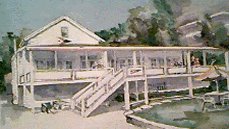 On the other hand, there are some very nice yacht clubs on City Island, such as the Harlem Yacht Club and the City Island Yacht Club. I've decided to join City Island Yacht Club because they seem more in line with my less than formal attitudes. Harlem seems too formal, too old. I could be wrong. But there you have it.
On the other hand, there are some very nice yacht clubs on City Island, such as the Harlem Yacht Club and the City Island Yacht Club. I've decided to join City Island Yacht Club because they seem more in line with my less than formal attitudes. Harlem seems too formal, too old. I could be wrong. But there you have it.Anyway, last year I bought an Engle portable refrigerator/freezer which I love - it's efficient (.7 amp draw as a refrigerator, 2.3 as a freezer), quite nicely built, quiet, and not too heavy. It's a fair sized 35 qt. It holds enough packed properly for my usual 2 week summer cruise. But it does draw power.
Last summer, I experimented with it and found I could run the thing overnight and the stereo and my lighting and still start the engine with the same battery the next morning. I carry two group 31 deep cycle flooded batteries, so with one in reserve, all's good. But it takes an hour of motoring to fully charge the battery afterwards. Normally, this isn't a problem since every afternoon the wind dies and if I'm going somewhere, I have to motor.
But at a mooring, I'd like to be able to leave the boat with the refrig on for extended periods without draining the battery - the reefer has a low voltage cut-off, but if there's food in it, that's the end of that. And I hate touching rotted whatever! Also, there is a great feeling in being energy independent - even if the motor doesn't, can't or won't run, I'll still have power for instruments, refer, and autopilot.
Towards this goal, my first idea was to go solar - I have a space on the seahood that will hold two 22 watt solar panels from Sundance Solar in Warner, NH. I've searched the web pretty thouroughly and they've had the best overall pricing. In fact, my friend Dale who is now living on the side of a mountain in Maui, Hawaii, is using a similar setup that I recommended.
Anyway, they have the panels and since each will put out 1.5 amps at optimal sunlight, I figured to run the refer and keep the batteries charged, they'd average about 1/3 - or .5 amp each. Two gives me 1 amp, which powers the refer and leaves .3 amp for charging. Since the nights are short in the summer and the sun brighter, I'd expect this set up to work for several weeks at a time before the low voltage cut-off kicked in. The price for this setup including the two panels and the charge controller is about $550. You absolutely need the controller.
My friend Herb (of Herb and Gina fame) also has a rebuilt Balmar alternator that I think is 100 amp - significantly larger than my current 35 amp one - that he's willing to give me. This would be great, because it could reduce the engine run time to charge the batteries.
But we all know that as soon as you put one piece of gear on a boat, you want another and that changes the energy balance, and so on and so on. I thought about this for a bit and decided to call Jack Rabbit Marine (who you'll see in the left column now as a marine electrical system supplier). I spoke at length with Steven Ivers, a certified ABYC Marine Electrical person.
What he recommended was changing my electrical system to provide for separation of the starting battery and the house bank. In addition he recommended an Echo Charger to manage the batterys properly. He also provided a simplified diagram for how this could be accomplished. If you are thinking of upgrading your electrical system on your boat, these people (Jack Rabbit Marine) are your go-to guys. I heartily recommend them.
 They also have a terrific wind generator package if you're doing costal sailing. It's the new Air-x 400 with mounting pole for less than $1000. Very nice.
They also have a terrific wind generator package if you're doing costal sailing. It's the new Air-x 400 with mounting pole for less than $1000. Very nice.Anyway, I've ordered the two solar panels and we'll see where that leads... Next week will be interesting, and I hope warm enough to either sail or to check the mounting/fitting of the panels.
See you on the water!
Sunday, February 05, 2006
Some People Are Living the Dream
First, you'll need to know more about narrowboats. I mean, other than they're boats and they're narrow. They are barges designed for traveling the English canal system.
In the late 1700's during the very beginning of the Industrial Revolution, entrepreneurs realized the importance and convienience of using waterways to move raw material and goods between factories, markets, and suppliers. To this end they created a huge network of canals and other waterways for transport.
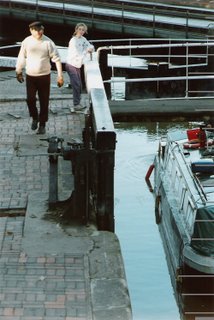
The total length of the water system is over 4000 miles, including canals, lakes and rivers. It includes some spectacular engineering - for instance, the Falkirk Wheel, which is a rotating boat lift. There are also elevated canals where you can float along an aerie, a hundred feet above the valley floor!
The UK has recently started programs for refurbishing and restoring the canal systems. It's been a major undertaking, but well worth it! The Falkirk Wheel site has a lot of history and information on the system. The IWA ( Inland Waterways Association ) also has a tremendous amount of information on the waterway and their restoration.
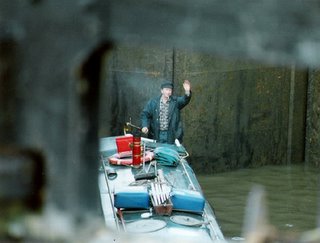
This all said, a narrowboat is barge, essentially, built for moving goods along the English canals. When they were originally built with manual labor it was decided that a good minimum width was somewhere around eight feet, apparently. Let's face it, if you've got to dig with shovel and pick, you'd rather dig something narrow than something like the Panama Canal. I know I would, anyway.

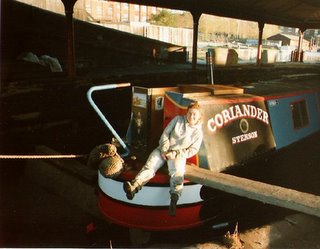
A number of people live on these boats, refurbishing them to quite luxurious homes. They are self powered, and at a around 7 feet wide by 55 feet long, provide a fairly large living space. Renee's is steel hulled. She's graciously provided some pictures of Coriander in drydock.
 Every few years, like any other boat, Corry (short, she indicates, for 'Coriander') requires serious maintenance. Zinc replacement and other underwater inspection and painting are done. Clearly, it's a big job and Renee, like myself, does it herself (except welding and that sort of thing). I suspect that she'd do that, too, if she owned the equipment!
Every few years, like any other boat, Corry (short, she indicates, for 'Coriander') requires serious maintenance. Zinc replacement and other underwater inspection and painting are done. Clearly, it's a big job and Renee, like myself, does it herself (except welding and that sort of thing). I suspect that she'd do that, too, if she owned the equipment!Please enjoy these pictures! Renee is refurbishing the interior that I have heard can be luxurious, and has promised pictures! So more on these lovely, useful, and comfortable boats later, I hope.
Well, see you on the water!
Monday, January 30, 2006
Now We're Talkin'!
 Saturday, January 28th, was a gorgeous day on the Hudson - 60 degrees, wind between 8 and 12, gusting to 18 maybe. In other words, perfect for trying out all my new sails.
Saturday, January 28th, was a gorgeous day on the Hudson - 60 degrees, wind between 8 and 12, gusting to 18 maybe. In other words, perfect for trying out all my new sails.Since Laura is in Ecuador with Healing the Children ( http://www.htcne.org/ ) and Herb and Gina were doing the home stuff, I invited Jack and Lou.
Jack is a friend from the Harbor House Marina in Connecticut. He's a singlehander, too, and has terrific taste in boats. Currently, he's the proud owner of an Olsen 38 that he's rebuilding. Well the wood part, anyway. Incredible patience.
Funny story about Lou - He's actually the one responsible for my being in boating in the first place. I'd like to say he tutored me in the ways of the sea and slowly drew me into a sailing life. But it wasn't like that at all. He owned Mudlark at the time and had invited my first ex-wife and I sailing. We thought that a splendid idea!
So off we all went. Over the afternoon, Lou allowed me to steer the boat. As I was merrily tacking and jibing, we came to a point we were close hauled and sailing for all the little boat was worth. Lou, being Lou, was fooling around. One of his little tricks was to lay against the jib. Well, since it was a small boat, the only thing holding the sheet was a jam cleat - And as we had been sailing about for a while so the sheet was wet, as Lou put all his weight against the aft end of the jib, the cleat released the line.
I still carry the look on his face as he realized that there was no recovery from this and that as the jib released, he was going for a swim. His glasses went in one direction and he in the other
and all in the drink.
Mudlark and I continued on, trying to decide whether to return to Haverstraw Marina to get help (certainly an hour or more) or to jibe and get back to Lou and recover him. And so, my first jibe on Mudlark ensued and my first (and hopefully last) man overboard recovery.
Lou and I became partners in Mudlark. We sailed her throughout the Long Island Sound, Block Island Sound and Gardiner's bay/Shelter Island. I learned a lot from Lou, and Mudlark singlehanding. I've said this before and I'll reiterate it now: A boat like Mudlark is the perfect boat to learn on. She was forgiving, strong, fun to sail, and no matter how badly I personally screwed up, she'd get me back to the dock.
But I digress.

Back to Saturday - as you've been more or less kept aware, I've gotten a full set of new sails and it was the perfect day to try them - new jib, new spinnaker, and new main (although the main had been inaugurated on January 1st). As you'd expect, I have some pictures that Lou took - that would be Lou Spitz Photography.
Jack who has been sailing Long Island Sound for, well, for ever. His observation of sailing the Hudson was that between the currents, shifting winds, shallows and so forth, it's pretty difficult sailing. You could, without much trouble sail an entire circle without tacking or jibeing. No kidding. Makes racing very interesting!
 My friend Renee in England, you know the one that lives on a narrowboat, has sent me some pictures that I will use in an entirely new post. But I have to tell you - the length is 55 feet, not 35 as I mentioned. Oops. Sorry, Renee!
My friend Renee in England, you know the one that lives on a narrowboat, has sent me some pictures that I will use in an entirely new post. But I have to tell you - the length is 55 feet, not 35 as I mentioned. Oops. Sorry, Renee!All that said, these 55 or 60 degree days during the winter weekends are terrific! Too bad they presage global warming.
Well, I hope I see some of you on the water!





